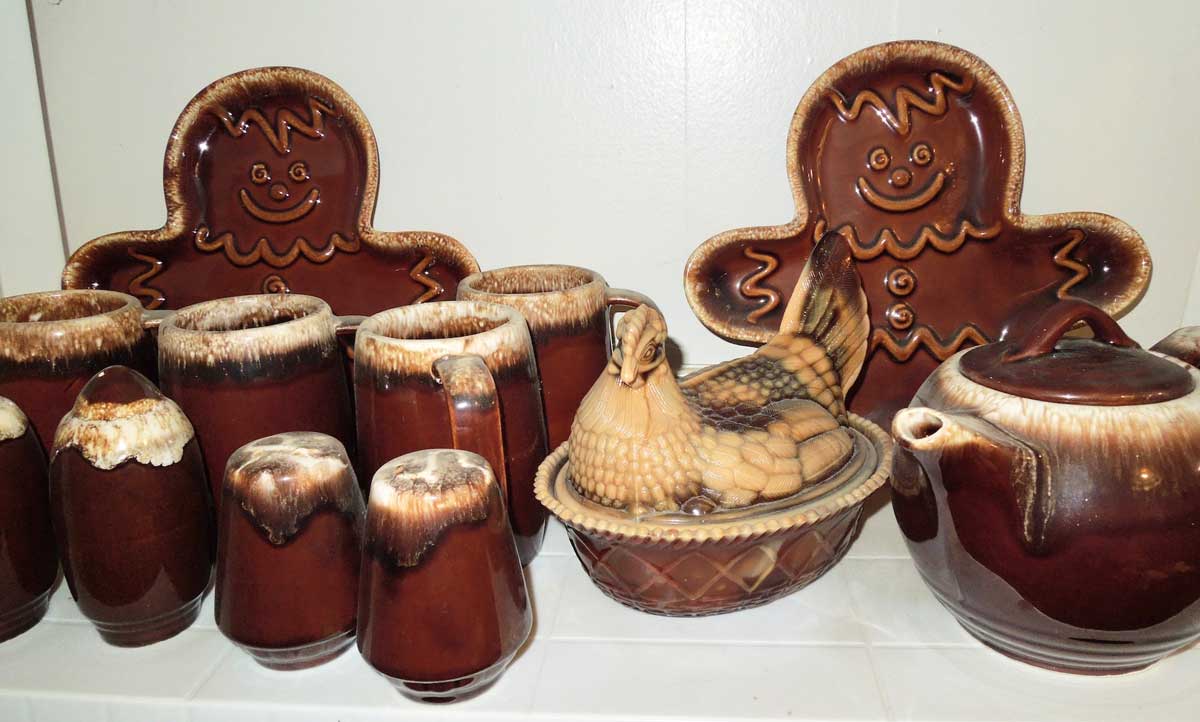February 2025
Good Eye
Some ‘almost’ antique kitchen and dinnerware
by Peggy Whiteneck
When I began collecting mid-century American-made kitchen and dinnerware sets, I quickly learned that even items made by entirely different manufacturers could be pleasingly matched on the same table. Fast-selling dinnerware sets were imitated by competing companies. My first discovery of this phenomenon was in Brown Drip pottery dinnerware, made by Hull (from the 1960s to ‘80s) and McCoy potteries (from 1968), both no longer in production. These are so closely aligned in color and foam treatment that they are virtually indistinguishable from one other without flipping the items over to check the mark. What this allows one to do is mix and match the items so as to make complete sets despite their not all being in the same brand (Such is not the case with Pfaltzgraff brown foam from the 1940s, where the brown in the body is so dark as to be nearly black that tends to clash with the lighter brown of the other two brands. As with the other two companies, though, Pfaltzgraff is no longer in production).
Then I found a hen on nest casserole dish that looked very much like my brown foam sets. It turned out to be made of glass rather than pottery, but its mix of brown and tan colors displays quite nicely among my Hull and McCoy. The hen on nest has a Westmoreland mark.
Fiesta is a pottery dinner and kitchenware brand known for its colorful mix and match sets, whose earliest colors, beginning in 1936 and into the 1950s, have become very collectible: red, yellow, cobalt blue, green, and ivory and (added in 1937) turquoise. With a gap during World War II, the red continued in production through 1972. Other colors, e.g., rose and gray, are more recent. The earliest Fiesta pieces have an inked backstamp on the bottom that says GENUINE (in caps) and fiesta (in lower case). The Homer Laughlin Co. dates from 1877 and is still in business.
My parents were early collectors of Depression Glass, and when my mom was trying to clear out some collectibles (to make room for others!), she gave some Depression dinner sets to my three sisters and me. Luckily, we were each attracted to different sets! I had always loved the American Sweetheart Monax dinnerware, of which my mom had nearly a complete set. Monax is a white color that thins to an almost transparent opalescence around the edges. Mom also gave me her set of Monax Petalware made by MacBeth-Evans in the 1930s (making it nearly antique!), which features a similar opalescence and matches nicely to fill in empty spots in my American Sweetheart set – which was, incidentally, made by the same company in the same era. I have long been struck by the fact that Depression glass, cheaply made at manufacture, has lasted so well for nearly a hundred years!
Recently, I found in an antique shop a set of four stemmed tumblers in Fenton’s French Opalescent hobnail, which matches very nicely with my Monax dishes. This Fenton tableware was made between 1940 and the early 1950s. I confess I’ve never personally seen the dinner and other plates in this treatment, but they are listed in books such as Margaret and Kenn Whitmyer’s Fenton Art Glass Patterns, 1939-1980.

This photo has just a sample of the approximately 200 pieces of Brown Drip pottery in my collection. The two rare gingerbread trays were made by Hull, as were the mugs at left. The salt shakers are probably Hull (bottoms too small for a mark). The teapot at right is McCoy. The hen on nest is Westmoreland Glass that matches nicely with the pottery. Note: the bottom rims of these American pottery pieces are the off-white of the original clay used to make them. Brown Drip was also imitated by Japanese companies, but the unglazed bottom rims on those will be brick red. (Image courtesy of the author)arketed under a Christmas name (here, “Christmas Star Series”) featured decoration that was more generically winter-themed. (Image courtesy of the author)
Amateur collectors often confuse Moonstone, made by Anchor Hocking beginning in 1942, with Fenton’s French Opalescent hobnail pieces. The hobnails on Moonstone are rounded at tips whereas Fenton’s are pointed, and the shapes of the pieces are often distinct from each other as well. Some pieces with basic forms, such as creamer and sugar, may complete a table set with Fenton. Moonstone was also made in other colors: pink, ruby, and clear with a red trim.
Some of the basic pieces from these various dinnerware sets can still be found in antique shops, but nearly all items are becoming increasingly scarce.
So grab ‘em while you still can!
Peggy Whiteneck is a writer, collector, and dealer living in East Randolph, VT. If you would like to suggest a subject that she can address in her column, email her at allwritealready2000@gmail.com.

